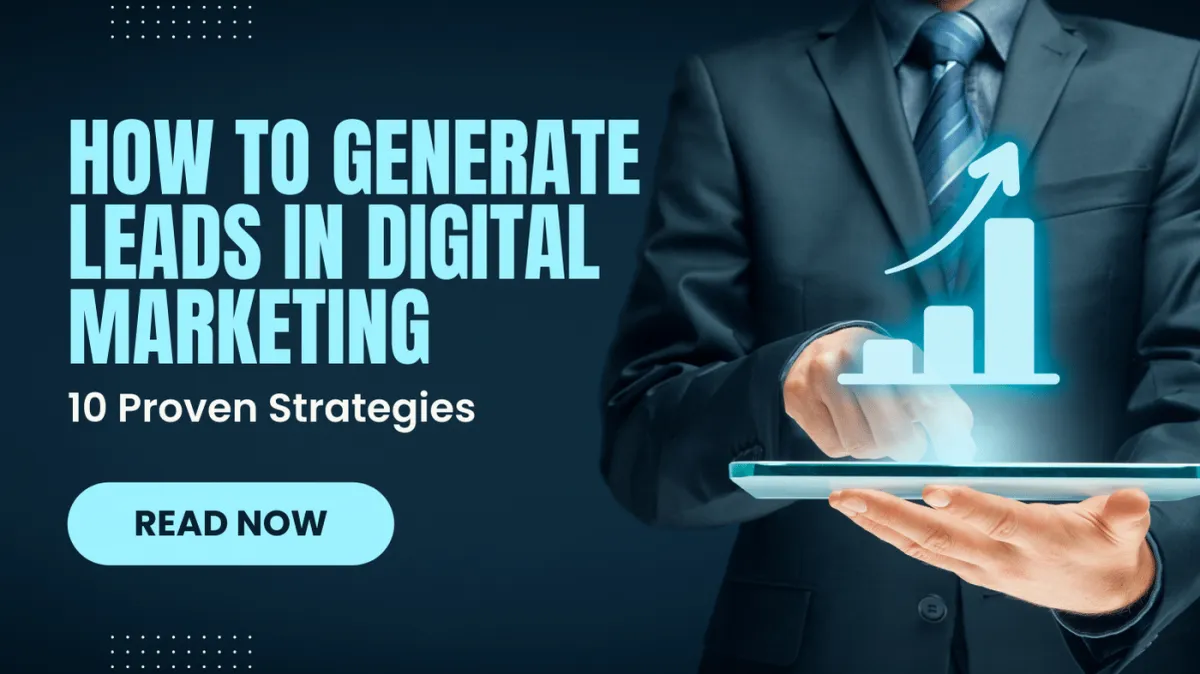Marketing, Business and Technology Blogs

How to Generate Leads in Digital Marketing: 10 Proven Strategies
Introduction:
In the fast-paced world of digital marketing, where competition is fierce and the digital landscape is constantly evolving, lead generation is the lifeblood of success. Whether you're a seasoned marketer or just dipping your toes into the digital waters, understanding the art and science of lead generation is crucial. In this comprehensive guide, we will delve into the intricacies of generating leads in the digital realm, exploring strategies that can propel your business to new heights.
The Importance of Lead Generation
In the digital age, where every click and scroll can be monetized, businesses are vying for the attention of their target audience. Lead generation is the process of capturing the interest of potential customers or leads and nurturing them through the sales funnel until they become paying customers. It's the driving force behind business growth and revenue generation in the online world.
The Competitive Digital Landscape
The digital landscape is a battleground where businesses of all sizes compete for the attention of a global audience. With millions of websites, social media platforms, and digital advertising campaigns vying for the same eyeballs, standing out from the crowd has become a formidable challenge. Effective lead generation is the secret weapon that enables businesses to rise above the noise and capture the hearts and wallets of their ideal customers.
Significance of Effective Lead Generation Tactics
In the digital realm, not all leads are created equal. Generating a massive number of low-quality leads may boost your metrics temporarily, but it won't translate into sustainable business growth. Effective lead generation tactics are essential for several reasons:
• Efficiency: They ensure that your marketing efforts are focused on potential customers who are more likely to convert, saving you time and resources.
• Cost-Effectiveness: Quality leads are more likely to convert, reducing customer acquisition costs over time.
• Customer Loyalty: Nurturing leads effectively can turn them into loyal, repeat customers, providing long-term value.
• Data-Driven Decisions: Effective lead generation relies on data and analytics, enabling you to make informed marketing decisions.
Now, let's dive into the heart of lead generation.
1. Understand the Basics of Lead Generation
Defining Lead Generation
Lead generation is the process of attracting and converting strangers and prospects into people who have indicated an interest in your company's product or service. These individuals, known as leads, have the potential to become paying customers.
The Role of Leads in the Sales Funnel
Leads are not mere statistics; they play a critical role in the sales funnel:
• Top of Funnel (TOFU): Leads at this stage are exploring their problems and potential solutions. They are seeking information and may not be ready to make a purchase.
• Middle of Funnel (MOFU): In this stage, leads have identified their problem and are actively researching solutions. They are open to considering different options.
• Bottom of Funnel (BOFU): At this stage, leads have decided on a solution and are evaluating specific products or services. They are close to making a purchase decision.
Quality Over Quantity
It's a common misconception that more leads equal more sales. In reality, the quality of leads matters just as much, if not more, than the quantity. A smaller number of highly qualified leads is often more valuable than a large pool of unqualified leads.
2. How Do Digital Marketers Generate Leads?
Now that we've established the importance of lead generation let's explore how digital marketers generate leads in the first place. The methods used are as diverse as the digital channels available. Here are some common approaches:
• Content Marketing: Creating and promoting valuable content to attract and engage potential leads.
• Search Engine Optimization (SEO): Optimizing online content to improve search engine rankings and visibility.
• Email Marketing: Sending targeted email campaigns to a list of subscribers.
• Social Media Marketing: Leveraging social media platforms to connect with and engage potential leads.
• Pay-Per-Click (PPC) Advertising: Running paid advertising campaigns to drive traffic and leads.
The Diversity of Digital Channels
In today's digital landscape, there's no shortage of channels to explore for lead generation:
• Websites: Your website is often the first touchpoint for potential customers, making it a prime lead generation asset.
• Social Media: Platforms like Facebook, Twitter, LinkedIn, and Instagram offer powerful tools for connecting with potential leads.
• Search Engines: Google and other search engines are gateways to a massive audience actively searching for solutions.
• Email: Email remains a reliable and cost-effective channel for lead nurturing.
• Online Advertising: Paid advertising, including display ads and social media ads, can rapidly expand your reach.
In the next section, we'll delve into three key methods of lead generation.
3. The Three Key Ways to Generate Leads
Lead generation encompasses a variety of methods, but at its core, it can be categorized into three primary approaches:
Inbound Marketing
Inbound marketing focuses on attracting potential customers by creating valuable, informative, and engaging content. Instead of pushing your message outwardly, you draw customers in by addressing their needs and pain points.
Advantages:
• Cost-effective: Content creation costs less than traditional advertising.
• Builds trust: Providing valuable information establishes your authority in your industry.
• Long-lasting results: Quality content continues to attract leads over time.
Disadvantages:
• Takes time to see results.
• Requires consistent content creation.
Outbound Marketing
Outbound marketing is the traditional form of advertising, where businesses initiate the conversation and send their message to a broad audience. This approach includes tactics like cold calling, print ads, and email blasts.
Advantages:
• Wide reach: You can reach a large audience quickly.
• Controlled messaging: You have full control over your message.
Disadvantages:
• High costs: Outbound marketing campaigns can be expensive.
• Lower engagement: Many outbound tactics have low response rates.
Content Marketing
Content marketing falls under the umbrella of inbound marketing. It involves creating and distributing valuable, relevant, and consistent content to attract and engage a clearly defined target audience.
Advantages:
• Builds brand authority.
• Supports SEO efforts.
• Offers long-term value.
Disadvantages:
• Requires ongoing content creation.
• Results may take time to materialize.
In the following sections, we'll delve into specific strategies within these approaches and explore how to generate leads effectively, even on a budget.
4. Lead Generation on a Budget: How to Generate Leads for Free
Generating leads doesn't always require a hefty budget. Here are some strategies to help you get started on a shoestring budget:
• Leverage Social Media: Use your business's social media profiles to engage with your audience. Share valuable content, run contests, and actively participate in discussions to attract potential leads.
• Optimize Your Website: Ensure your website is well-optimized for search engines (SEO). This will increase your organic visibility and attract organic traffic.
• Create Compelling Content: Content marketing is cost-effective. Create blog posts, videos, infographics, and other content that addresses your audience's pain points.
• Email Marketing: Start building an email list and send regular newsletters or updates. Email marketing remains one of the most affordable ways to nurture leads.
• Networking: Attend industry events, webinars, and online forums. Building relationships with peers and potential clients can lead to valuable referrals.
5. Generating Leads from Day 1
Generating leads from the very beginning of your digital marketing journey is not only possible but highly recommended. Here's how:
• Define Your Target Audience: Understand who your ideal customers are, where they hang out online, and what problems you can help them solve.
• Create a Lead Magnet: Develop a valuable lead magnet, such as an eBook, webinar, or free consultation, to entice potential leads to share their contact information.
• Landing Pages: Design dedicated landing pages for your lead magnets. These pages should be optimized to capture leads effectively.
• Social Media Engagement: Engage with your target audience on social media platforms by sharing valuable content and participating in conversations.
6. Understanding B2B Lead Generation
B2B (business-to-business) lead generation focuses on targeting other businesses as potential clients. Here's why it's unique:
• Complex Sales Cycles: B2B sales often involve longer, more complex decision-making processes.
• Multiple Decision-Makers: Several stakeholders within a company may influence the purchase decision.
• Personalization: Tailoring your approach to each potential client is essential in B2B lead generation.
7. Where to Find Lead Sources
Discovering lead sources involves exploring various online platforms and strategies:
• Social Media: Platforms like LinkedIn, Twitter, and Facebook offer excellent opportunities to connect with potential leads.
• Websites: Your website is a powerful lead generation tool. Optimize it to attract and convert visitors into leads.
• Industry Forums: Participate in forums or communities related to your niche. Engage in discussions and showcase your expertise.
8. Identifying Basic New Leads
Understanding where your leads are in their buyer's journey is crucial:
• Top of Funnel (TOFU): Leads at this stage are in the awareness phase. They've identified a problem and are seeking information.
• Middle of Funnel (MOFU): MOFU leads are considering potential solutions and evaluating options.
• Bottom of Funnel (BOFU): BOFU leads are ready to make a decision and may need a nudge in the right direction.
Identifying where your leads are in this journey helps tailor your communication and offers effectively.
9. The Role of SEO in Lead Generation
Search Engine Optimization (SEO) is integral to lead generation. By optimizing your content and website for search engines, you increase your visibility to potential leads actively searching for solutions.
• Keyword Research: Identify relevant keywords that your potential leads are searching for.
• On-Page SEO: Optimize your website's pages, including meta descriptions and titles, for search engines.
• Content Quality: Create high-quality, informative content that addresses your audience's needs.
10. Is Lead Generation Hard?
Lead generation can be challenging, but it's not insurmountable. Success in lead generation requires:
• Strategy: A well-thought-out lead generation strategy tailored to your business and audience.
• Persistence: Consistent effort and adaptability to refine your strategies.
• Analytics: Monitoring and analyzing your lead generation efforts to make data-driven improvements.
Conclusion
Lead generation is the lifeblood of successful digital marketing. Understanding the basics, exploring various strategies, and adapting to the ever-changing digital landscape are essential for continued growth. Remember, quality leads are the key to sustainable success.
As you embark on your lead generation journey, keep in mind that it's a dynamic process that evolves with technology and consumer behavior. Be open to experimentation, embrace new technologies, and, most importantly, prioritize delivering value to your leads.
In the fast-paced world of digital marketing, adaptability and innovation will be your most potent tools for generating leads and driving your business forward.
Additional Resources
For more insights on digital marketing, lead generation, and other related topics, check out these articles:
• 10 Questions Answered About Creating Local Microsites for Boosting Sales
• Dare to Dream: Conquering Fear as a New Business Owner
• Data-Driven Digital Marketing Strategies to Maximize ROI
• Enhancing Your Digital Marketing Strategies
• The Future of Social Media Marketing: AI in Social Media Marketing
• How to Cook Up a Profitable Side Hustle in 2023: The Ingredients
• How to Drive Audience Engagement Using Content Marketing
Done For You Sales Qualified lead Gen Services
Experience seamless lead generation with our Done For You Sales Qualified Lead Generation Services. Our expertly crafted marketing program ensures a steady flow of prospects who are actively seeking your services.
We meticulously double-verify the interest of each lead via phone, guaranteeing high intent and sales qualification. Within minutes, these leads are seamlessly funneled into your CRM or Marketing Automation platform of choice, ready for immediate action. Trust us to deliver the highest quality standard for your lead generation needs, just like some of the largest companies in the industry have experienced massive success with our program. Let us handle the heavy lifting while you focus on growing your business.

Innovation
Fresh, creative solutions.

Integrity
Honesty and transparency.

Excellence
Top-notch services.

FOLLOW US
COMPANY
CUSTOMER CARE
LEGAL
Free Resources
©Copyright 2026. shoeblodhi.com in partnership with VMarket Digital. All Rights Reserved.

